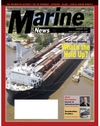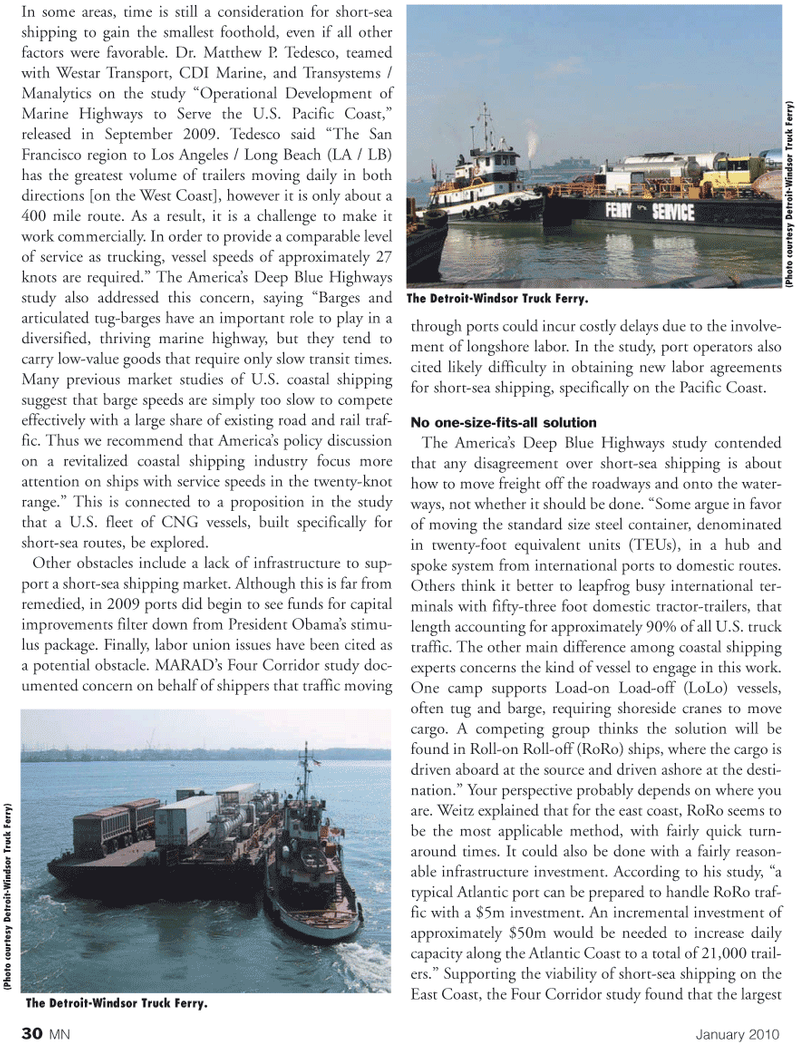
Page 30: of Marine News Magazine (January 2, 2010)
Read this page in Pdf, Flash or Html5 edition of January 2, 2010 Marine News Magazine
30 MN January 2010
In some areas, time is still a consideration for short-sea shipping to gain the smallest foothold, even if all other factors were favorable. Dr. Matthew P. Tedesco, teamed with Westar Transport, CDI Marine, and Transystems /
Manalytics on the study “Operational Development of
Marine Highways to Serve the U.S. Pacific Coast,” released in September 2009. Tedesco said “The San
Francisco region to Los Angeles / Long Beach (LA / LB) has the greatest volume of trailers moving daily in both directions [on the West Coast], however it is only about a 400 mile route. As a result, it is a challenge to make it work commercially. In order to provide a comparable level of service as trucking, vessel speeds of approximately 27 knots are required.” The America’s Deep Blue Highways study also addressed this concern, saying “Barges and articulated tug-barges have an important role to play in a diversified, thriving marine highway, but they tend to carry low-value goods that require only slow transit times.
Many previous market studies of U.S. coastal shipping suggest that barge speeds are simply too slow to compete effectively with a large share of existing road and rail traf- fic. Thus we recommend that America’s policy discussion on a revitalized coastal shipping industry focus more attention on ships with service speeds in the twenty-knot range.” This is connected to a proposition in the study that a U.S. fleet of CNG vessels, built specifically for short-sea routes, be explored.
Other obstacles include a lack of infrastructure to sup- port a short-sea shipping market. Although this is far from remedied, in 2009 ports did begin to see funds for capital improvements filter down from President Obama’s stimu- lus package. Finally, labor union issues have been cited as a potential obstacle. MARAD’s Four Corridor study doc- umented concern on behalf of shippers that traffic moving through ports could incur costly delays due to the involve- ment of longshore labor. In the study, port operators also cited likely difficulty in obtaining new labor agreements for short-sea shipping, specifically on the Pacific Coast.
No one-size-fits-all solution
The America’s Deep Blue Highways study contended that any disagreement over short-sea shipping is about how to move freight off the roadways and onto the water- ways, not whether it should be done. “Some argue in favor of moving the standard size steel container, denominated in twenty-foot equivalent units (TEUs), in a hub and spoke system from international ports to domestic routes.
Others think it better to leapfrog busy international ter- minals with fifty-three foot domestic tractor-trailers, that length accounting for approximately 90% of all U.S. truck traffic. The other main difference among coastal shipping experts concerns the kind of vessel to engage in this work.
One camp supports Load-on Load-off (LoLo) vessels, often tug and barge, requiring shoreside cranes to move cargo. A competing group thinks the solution will be found in Roll-on Roll-off (RoRo) ships, where the cargo is driven aboard at the source and driven ashore at the desti- nation.” Your perspective probably depends on where you are. Weitz explained that for the east coast, RoRo seems to be the most applicable method, with fairly quick turn- around times. It could also be done with a fairly reason- able infrastructure investment. According to his study, “a typical Atlantic port can be prepared to handle RoRo traf- fic with a $5m investment. An incremental investment of approximately $50m would be needed to increase daily capacity along the Atlantic Coast to a total of 21,000 trail- ers.” Supporting the viability of short-sea shipping on the
East Coast, the Four Corridor study found that the largest
The Detroit-Windsor Truck Ferry. (Photo courtesy Detroit-Windsor Truck Ferry)
The Detroit-Windsor Truck Ferry. (Photo courtesy Detroit-Windsor Truck Ferry)

 29
29

 31
31
